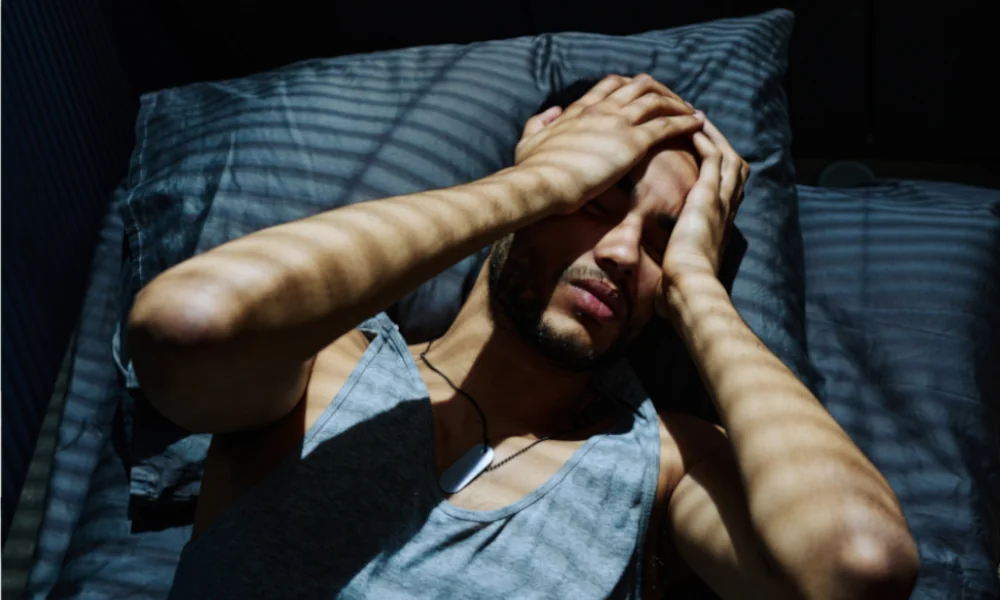Sleep paralysis is a phenomenon experienced by a significant portion of the population, with varying prevalence rates across different demographics. A comprehensive review of multiple studies revealed that approximately 7.6% of the general population had experienced at least one episode of sleep paralysis in their lifetime. This prevalence increases dramatically among specific groups, with 28.3% of students and 31.9% of psychiatric patients reporting experiences of sleep paralysis. Notably, the rate is even higher among psychiatric patients with panic disorder, with 34.6% reporting lifetime sleep paralysis experiences. This article will explore the symptoms, causes, impact, and prevention of sleep paralysis, as well as provide strategies for coping with this disease.
What is sleep paralysis?
Sleep paralysis is a temporary inability to move or speak that occurs when falling asleep or waking up. During these episodes, individuals find themselves conscious but unable to control their body movements. This can be accompanied by vivid and often frightening hallucinations. The primary physical sensation during sleep paralysis is a complete inability to move voluntary muscles despite being mentally aware. This paralysis can extend to the ability to speak, creating a sense of being trapped in one’s own body. Many people also report difficulty breathing, although this is typically a perception rather than a real respiratory issue.
Hallucinations during sleep paralysis are typically intense and multisensory and can be categorised into two main types, vestibular-motor (V-M) hallucinations and intruder hallucinations. V-M hallucinations include sensations of floating, flying, and out-of-body experiences, while intruder hallucinations involve perceiving a presence or experiencing visual and auditory phenomena of external entities. These can manifest as shadowy figures, whispers, or voices. Some individuals also report tactile sensations, such as chest pressure or a feeling of being touched. The vivid, often nightmarish nature of these hallucinations significantly contributes to the distress experienced during sleep paralysis episodes.
What does sleep paralysis feel like?
The experience of sleep paralysis is often described as terrifying and anxiety-inducing. The combination of physical immobility and vivid hallucinations can create a profound sense of helplessness and fear. Many people report feeling an evil or malevolent presence in the room, which intensifies the emotional distress of the episode.
Physically, individuals may feel a heaviness or pressure on their chest, as if something is sitting on them. This sensation, combined with the perceived difficulty in breathing, can lead to panic. The inability to call out for help or move away from perceived threats adds to the distress. Some people may experience night sweats during these episodes, further contributing to the discomfort.
Sensory experiences during sleep paralysis can be extremely vivid. Some people report seeing detailed figures or scenes, hearing distinct voices or sounds, and feeling realistic touch sensations. These hallucinations often have a nightmarish quality, contributing to the overall sense of fear and unease. The intensity of these experiences can lead to anxiety about sleep and may even result in sleep deprivation, which can have significant impacts on overall health and well-being.
Causes of sleep paralysis
Sleep paralysis is intricately linked to the rapid eye movement (REM) stage of sleep. During normal REM sleep, the brain induces atonia, a temporary paralysis of most voluntary muscles, to prevent individuals from physically acting out their dreams. Sleep paralysis occurs when there’s a misalignment between the brain’s sleep-wake cycle and this natural paralysis mechanism, resulting in a state where consciousness returns before the atonia dissipates.
Several sleep disorders can increase the risk of experiencing sleep paralysis. Narcolepsy, a condition characterised by excessive daytime sleepiness and sudden sleep attacks, is strongly associated with frequent sleep paralysis episodes. Insomnia, which often leads to irregular sleep patterns and increased stress, can also contribute to sleep paralysis. Sleep apnoea causes frequent breathing interruptions during sleep, which can lead to fragmented sleep and a higher risk of sleep paralysis. Circadian rhythm disorders, which involve a misalignment between the internal body clock and the external environment, can also disrupt sleep patterns and increase the likelihood of sleep paralysis.
Lifestyle factors play a significant role in the occurrence of sleep paralysis. Irregular sleep schedules, sleep deprivation, and excessive stress can increase the likelihood of episodes by disturbing the normal sleep cycle. Additionally, sleeping on one’s back (supine position) has been linked to a higher incidence of sleep paralysis, possibly due to increased pressure on the chest and potential breathing difficulties in this position.
Certain medications that affect sleep architecture or neurotransmitter systems may also impact the occurrence of sleep paralysis. These can include antidepressants, antipsychotics, and other medications that alter the balance of chemicals in the brain. Genetic factors also play a role, with hereditary predispositions increasing susceptibility. Environmental factors, such as noise levels, room temperature, and light exposure, can influence sleep quality and potentially contribute to sleep paralysis episodes.
How to stop sleep paralysis in the moment
When experiencing sleep paralysis, it’s crucial to remain as calm as possible and remember that the episode is temporary. While this can be challenging due to the intense fear often associated with sleep paralysis, understanding the nature of the phenomenon can help alleviate some of the panic.
One effective strategy for coping with sleep paralysis is to focus on small, controllable physical sensations. Attempting to wiggle a finger or toe can help re-establish the connection between mind and body. Some individuals find it helpful to concentrate on their breathing, taking slow, deep breaths to promote relaxation and combat the feeling of chest pressure. For those experiencing visual hallucinations, trying to focus on natural objects in the room can help ground them in reality. Counting familiar items or mentally describing the surroundings can shift attention away from frightening hallucinations and towards the actual environment.
Gradually attempting to move larger muscle groups, such as the arms or legs, can help break the paralysis. Visualising yourself slowly regaining control over your body can also be a powerful tool in overcoming the episode. This mental imagery, combined with physical effort, reinforces the connection between mind and body. Another technique that some find helpful is attempting to make small facial movements, such as blinking rapidly or moving the eyes. These actions can sometimes trigger a full awakening from the paralysis state. Additionally, trying to produce sounds, even if just a small grunt or hum, can activate the body’s motor functions and potentially end the episode.
How to prevent sleep paralysis
Maintaining a consistent sleep schedule is one of the most effective ways to reduce the occurrence of sleep paralysis. Try to go to bed and wake up at the same time each day, even on weekends. This helps to regulate your body’s internal clock and improve overall sleep quality. Stress reduction techniques can significantly decrease the likelihood of sleep paralysis episodes. Regular exercise, mindfulness meditation, and relaxation exercises like progressive muscle relaxation can all help manage stress levels. Cognitive-behavioral therapy (CBT) has also shown promise in reducing the frequency and intensity of sleep paralysis episodes.
Creating a sleep-conducive environment is crucial. Keep your bedroom dark, quiet, and cool. Avoid screens for at least an hour before bed, as the blue light emitted can interfere with your natural sleep-wake cycle. Establish a relaxing bedtime routine to signal to your body that it’s time to wind down.
The impact of sleep paralysis
The psychological effects of sleep paralysis can be significant, especially for those who experience frequent episodes. The intense fear and helplessness felt during an episode can lead to anxiety about going to sleep, potentially exacerbating sleep problems. Some individuals may develop a fear of sleep due to their experiences with sleep paralysis.
Some individuals may develop symptoms of depression as a result of particularly frightening or recurring episodes. Repeated episodes of sleep paralysis can disrupt overall sleep quality, leading to daytime fatigue, difficulty concentrating, and mood disturbances. This can affect work performance, social relationships, and general quality of life. The fear of experiencing sleep paralysis may cause some individuals to avoid sleep or engage in unhealthy sleep habits, further disrupting their sleep patterns.
There’s growing evidence suggesting a link between sleep paralysis and other mental health issues. Individuals with anxiety disorders, post-traumatic stress disorder (PTSD), and depression have an increased risk of sleep paralysis. Conversely, frequent sleep paralysis episodes may contribute to the development or exacerbation of these conditions.
Dealing with sleep paralysis
Sleep paralysis, while often frightening, is a common and generally harmless sleep phenomenon. Understanding its nature and underlying causes can go a long way in reducing the fear and anxiety associated with these episodes. With proper sleep hygiene, stress management techniques, and coping strategies, most individuals can significantly reduce the frequency and impact of sleep paralysis on their lives. Remember, you’re not alone in dealing with sleep paralysis. Many people experience this phenomenon, and there are effective strategies to manage and prevent episodes. With patience and persistence, it’s possible to overcome the challenges posed by sleep paralysis and achieve restful sleep.
If you’re experiencing recurring sleep paralysis that is significantly affecting your quality of life, it’s important to seek professional help. As a leading sleep specialist, we can provide a comprehensive evaluation and develop a tailored treatment plan to address your specific needs. Please feel free to contact us and take the first step toward a better night’s sleep.










